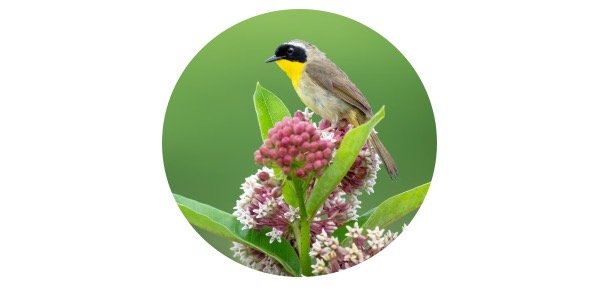17 Red Birds: Description, Pictures, and Tips to Attract
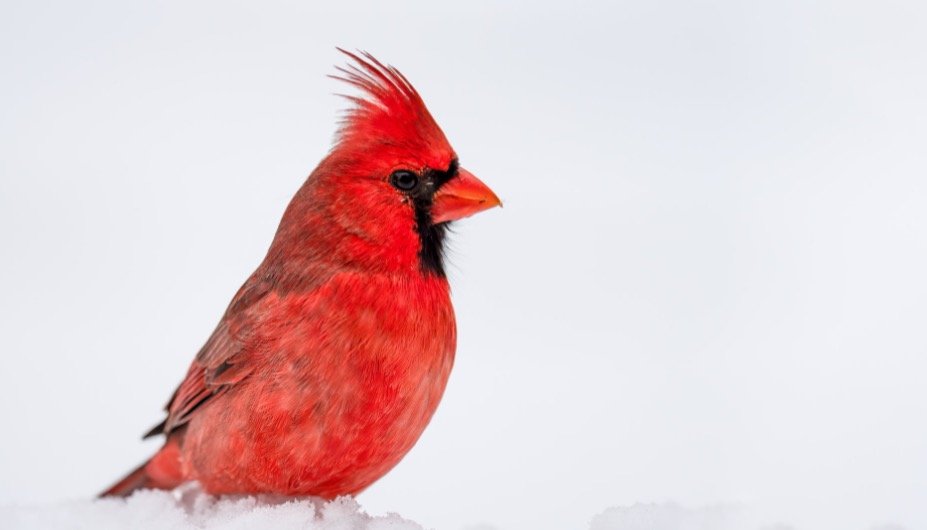
Red birds in North America are found in many different bird groups. Some are found in dry open areas, such as the Vermilion Flycatcher and the Pyrrhuloxia, whose habitat are sparse and dry. Others such as the Purple Finch, Scarlet Tanager and the Cassin’s Finch, favour the mixed forests as their homes. Then, there are the northern birds, such as the Pine Grosbeak, Red Crossbill and White-winged Crossbill.
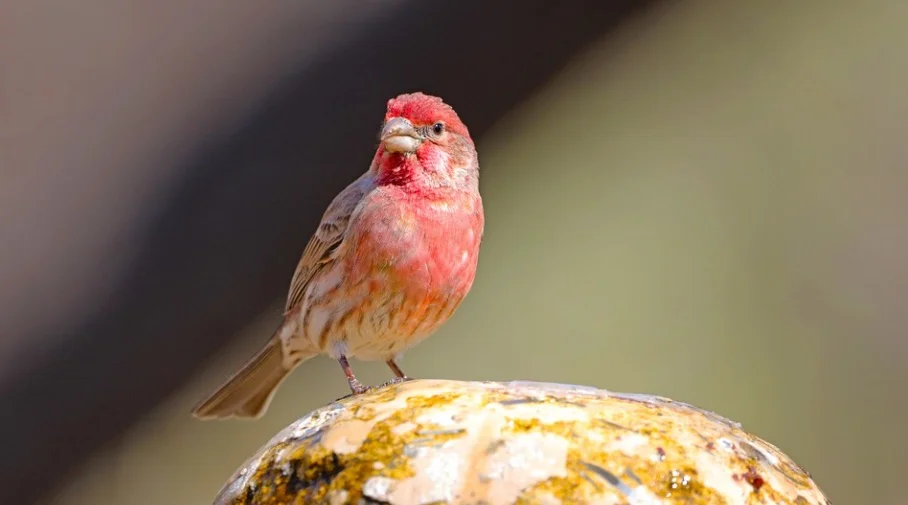
Some of these birds migrate, while others stay for the entire year. Of all colors, red is one of the most vibrant and easily seen shades, and there are many beautiful red birds throughout the world. The species represented here are the reddest, most colorful birds on the globe, and each one would be a colorful addition to any birder’s life list.
Northern Cardinal, Finches and tanagers whose bright red plumage is recognized by almost anyone who sees it and are the most common red-headed birds to see, but there are other kinds to learn about.
This guide will assist you in identifying the red-headed birds you have seen in North America. Discover which states these redbirds call home and where they may be found. There is no perfect list of red birds, and if we’ve left out your favorite red bird, feel free to let us know!
i. Northern Cardinal
The male Northern Cardinal has a vivid red head, body, and tail, as well as black around his face. They’re stunning, especially against a snowy winter backdrop. The females are likewise a bit spectacular with their brown coloration, pointed brown crest, red accents, and red beaks. It can grow to be 8.3 to 9.1 inches long, weigh 42 to 48 g, and have a wingspan of 9.8 to 12.2 inches. Northern Cardinals are distributed in eastern and southern states, and during mating season, they will occasionally fight their own reflection to protect their territories.
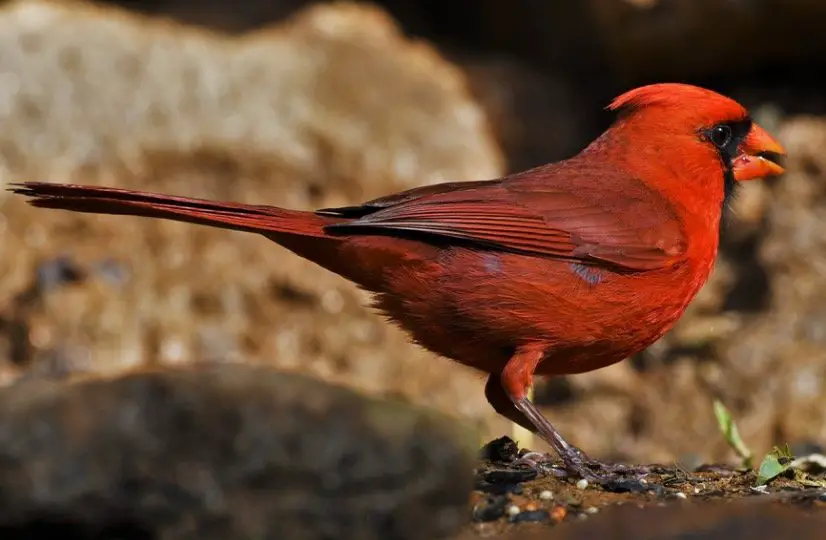
Tips to Attract Northern Cardinals to Your Yard
A native of North America, Northern Cardinals are often found feasting on sunflower seeds and other bird feeders. They build massive nests in large trees with soft twigs and leaves for nest lining. If you’re looking for a beautiful red cardinal, building a bird feeder is a great way to attract them! Try putting out some black-oil sunflower seeds or safflower seeds.
Sunflower seeds, peanut hearts, millet, and milo attract more Northern Cardinals to backyard feeders. Large tube feeders, hoppers, platform feeders, and food thrown on the ground will all be used to feed them. You can also experiment with native plants like coneflowers and swamp milkweed (both favorites among cardinals). Just make sure you place your bird feeder in an area that’s protected from predators (such as squirrels) and away from pesticides, since birds don’t always have access to clean water.
ii. Purple Finches
Purple Finches have a reddish-purple head and breast, with more brown on the back and wings, similar to House Finches. It can grow to be 4.7 to 6.3 inches long, weigh 18 to 32 grams, and have a wingspan of 8.7 to 10.2 inches. They breed in Canada and spend the winter in eastern states, but they may be seen all year long the Pacific coast’s north and east.
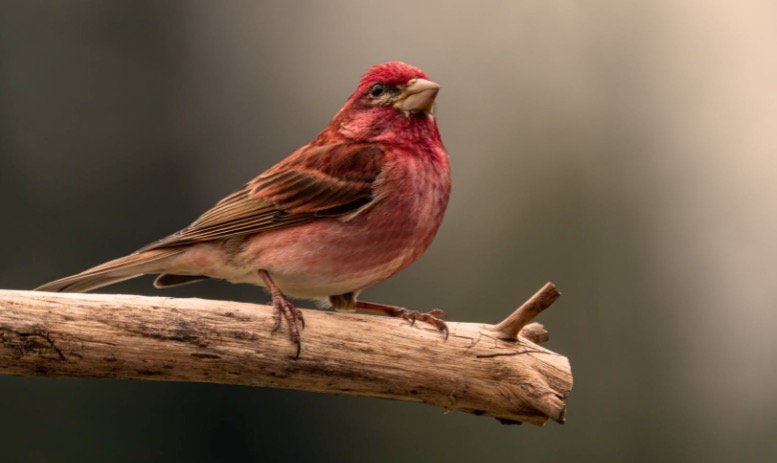
Tips to Attract Purple Finches to Your Yard
Purple finches are small songbirds that love warm, dry areas and feed on seeds. Purple finches generally only eat sunflower seeds, but they will sometimes eat millet as well. Putting up a finch feeder with both types of seed can help ensure you attract these beautiful birds. They eat seeds as well as blossoms, nectar, and berries, in evergreen woods. They flock to feeders in search of black oil sunflower seeds.
In general, you’ll have more success attracting purple finches in your yard if it’s free from tall trees that may obstruct sunlight and cause cold drafts. When putting out a bird feeder for purple finches, it’s best to hang it about 18 inches off the ground where sunlight can hit it directly. Make sure you check your bird feeders frequently since purple finches like to steal from other birds!
iii. House Finches
The male House Finches have a red head and breast, while the females have brown-streaked coloration. It has a wingspan of 7.9 to 9.8 inches and a length of 5.1 to 5.5 inches, and weighs up to 16 to 27 grams. It was originally exclusively found in western states, but it was brought to eastern states and has thrived, even displacing the Purple Finch. Parks, farms, woodland margins, and backyard feeders are all good places to look for them. They congregate in large, boisterous groups that are difficult to overlook.

Tips to Attract House Finches to Your Yard
House finches are a type of small bird that can be found in backyards across America. There are a number of steps you can take to attract house finches, and following these tips will increase your chances at spotting them in your yard. Black oil sunflower seeds or nyjer seeds in tube feeders or platform feeders can drive numerous house finches to backyard feeders.
They prefer having food sources close by, so planting a variety of seeds is recommended. It’s also helpful to build bird feeders yourself; most house finches enjoy using tube-shaped bird feeders, which you can create by poking holes in any empty water bottle or milk jug with an ice pick. Once your feeder is filled with seed and hung up in your yard, it should only take a few hours for your first finch visitor!
iv. Cassin's Finches
Cassin’s Finches have a red crown and rosy pink head, are red-breasted, have a whiteish tummy, and brown back and wings. They also have a red crown and rosy pink head. It can reach a length of 6.3 inches, weighs between 24 and 34 grams, and has a wingspan of 9.8 to 10.6 inches. They can be observed scavenging for seeds in flocks in western highland woods. They are not quite as abundant in back gardens as house or purple finches.
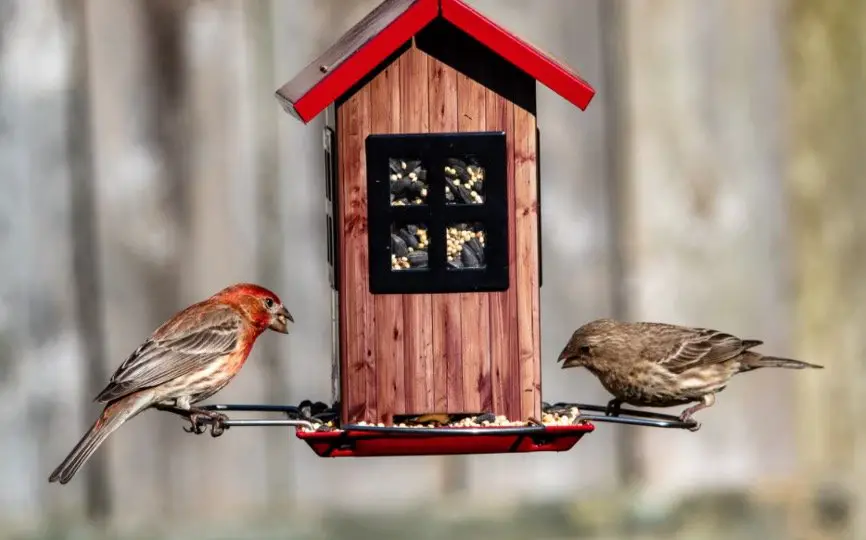
Tips to Attract Cassin's Finches to Your Yard
Research suggests that birds are drawn to homes that have some brushy vegetation near them. To attract Cassin’s finches, make sure you have some yucca plants and juniper shrubs in your yard. Sunflower seed feeders, especially during the winter, or fruiting bushes like cotoneaster, mulberries, firethorn, grape, and apple may attract them.
Also, try adding plenty of color with flowers that can be easily reached by finches such as California poppies, buckwheat, and clarkia. In addition, you might want to consider putting up a feeder so that you can make it easy for these birds to eat once they land in your yard.
v. Common Rosefinch
Male Common Rosefinch males have a vivid red head, breast, and rump, and a brown body with traces of red. It can reach a length of 5.8 inches, a weight of 23 grams, and a wingspan of 9.5 inches. Common Rosefinches are infrequently sighted in North America, as they are generally found in Europe and Asia, however they have been spotted on Alaska’s western border during the summer.
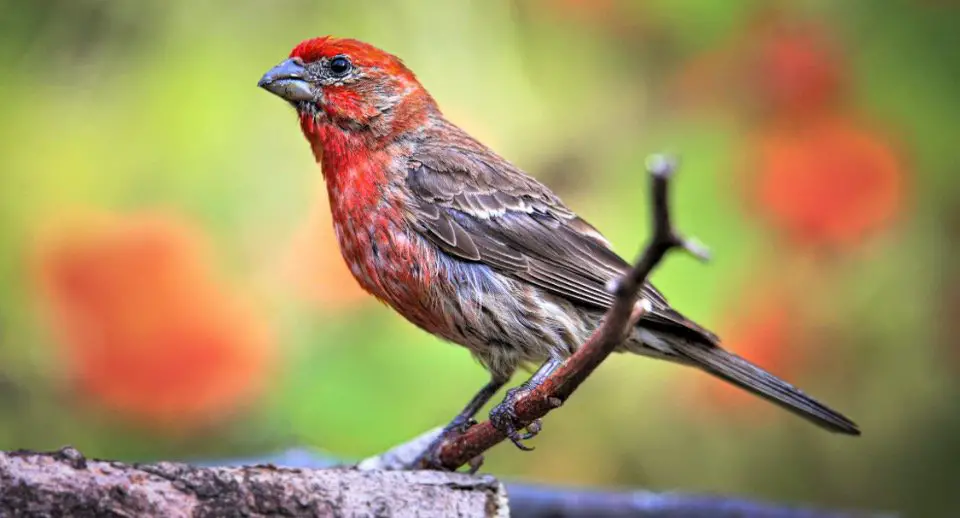
Tips to Attract Common Rosefinch to Your Yard
Rosefinches are small birds that love sunflower seed and peanuts. They will eat any type of seeds, fruit or nuts they can find in your garden or yard. One way to attract rosefinches is by planting sunflowers or niger seed in your backyard. Rosefinches are attracted to areas where other bird feeders have been placed, so it is best to put out several for maximum effect.
vi. Brown-capped Rosy Finch
Brown-capped Rosy Finch (Leucosticte australis) is a common red bird with a brighter reddish-pink tummy and wings during the mating season. They have brown capped bodies with streaks of pink on the remainder of their bodies. The majority of juveniles and non-breeding adults are brown. It has a wingspan of 13 inches, a length of 5.5 to 6.3 inches, and a weight of 23 to 33 grams. Brown-capped Rosy-Finch may be found in the highlands of Colorado and New Mexico, eating on seeds, insects, and spiders. They’ll flock to backyard feeders in search of sunflower or Nyjer seeds.
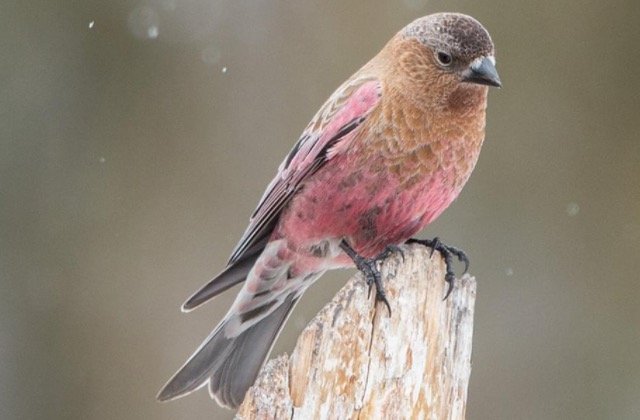
Tips to Attract Brown-capped Rosy Finch to Your Yard
You’ll need to provide both food and water for these finches if you want them to stick around, but once they have established a territory in your yard, you’ll be able to get up close and personal with them. Offer a birdbath for bathing, or suet feeders for their constant supply of insects.
You can offer seeds or fruit as food, but make sure there’s some protein too—seed alone isn’t enough. For best results, place each type of feeder at least 30 feet away from any other bird feeder you’ve set up in your yard. Rosy finches are aggressive toward other birds in general; you don’t want them attacking other types of birds that might land nearby.
vii. Common Redpolls
Reddish-browed Common Redpolls (Acanthis redpoll) have rosy breasts and are brown and white on the rest of their bodies. It has a wingspan of 7.5 to 8.7 inches and a length of 4.7 to 5.5 inches and weighs 11 to 20 grams. They are more common in northern regions during the winter, and less so in central states.
In the winter, they would dig tunnels into the snow to keep warm at night. They may consume up to 42% of their body weight in food each day and store up to 2 grams of seeds in a stretchy part of their oesophagus. They can be spotted in weedy areas or on tree catkins, but they will also come to feeders for tiny seeds like nyjer seeds or thistle.
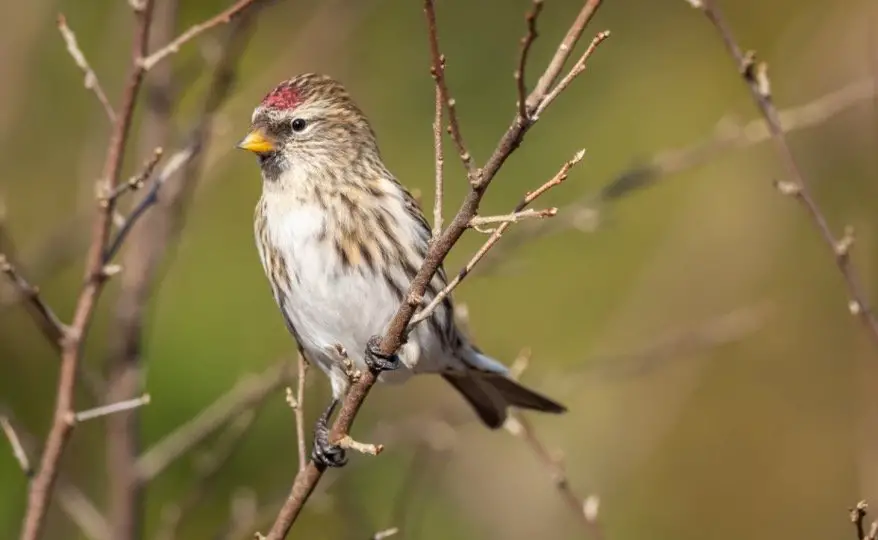
Tips to Attract Common Redpolls to Your Yard
Redpolls are small birds with a dark body and bright red patch on their heads. They eat seeds, so a bird feeder filled with black oil sunflower seeds will be sure to attract them. If you want to attract other species that eat sunflower seeds, make sure your feeder has a tray underneath it, so you can easily clean up any mess that falls through.
The best place for your feeder is somewhere in your yard where you’ll get an unobstructed view of it—an attic window works well for those who live in townhouses or apartments. Feeders need to be cleaned regularly, as mold will form if birdseed becomes wet and stale over time.
viii. Vermilion Flycatcher
The front of the Vermilion Flycatcher (Pyrocephalus rubinus) is brilliant red, while the rear is brown. Males have a dark mask covering their faces, while females have a light reddish belly and are grey and brown in colour. It may reach a length of 4.8 to 5.4 inches and weigh between 11.3 and 14.8 grams. They can be found all year in the extreme south, collecting insects or sitting on exposed perches in arid environments. They’re very widespread in the southwest, but they’re also seen in lower quantities on the Gulf Coast.
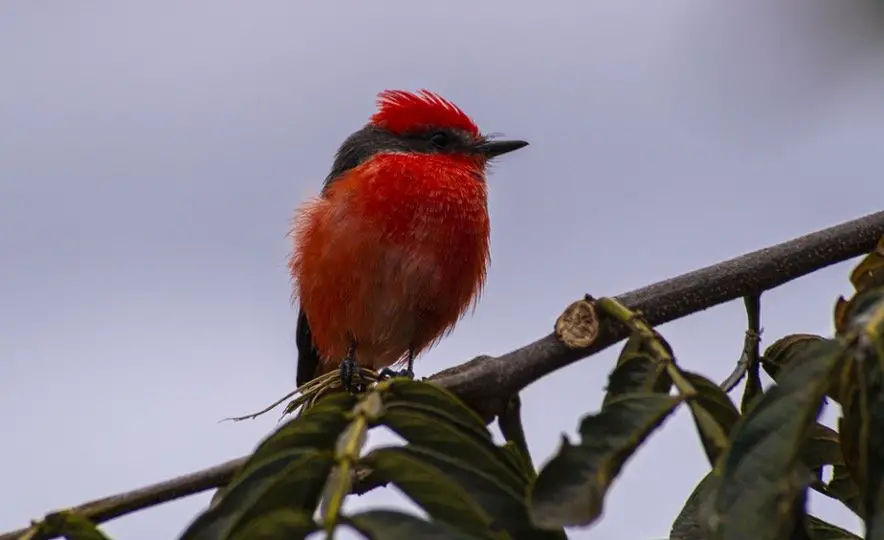
Tips to Attract Vermilion Flycatcher to Your Yard
This pretty little bird will impress you with its unique colors and personality. Keep a close eye on your feeder if you’re hoping to attract vermilion flycatchers: they tend to avoid others in their species, so an isolated feeder is best. If you live near trees, consider mounting one by a shrub or other natural cover; vermilion flycatchers prefer solitude but do prefer nearby cover for when predators are about.
You can expect male vermilion flycatchers to defend territory year-round (even during migration season). Females generally only defend territories from January through March and again from June through August. To keep vermilion flycatchers happy, place a platform feeder in your yard and make sure it has ample water source nearby.
ix. Scarlet Tanagers
Scarlet Tanagers (Piranga olivacea) have a vivid red plumage, black wings, and black tails. Females have darker wings and tails than males. It has a wingspan of 9.8 to 11.4 inches, a length of 6.3 to 6.7 inches, and weighs 23 to 38 grams. In the summer, they reproduce in eastern woodlands before travelling to South America. Because they like to stay high in the forest canopy, scarlet tanagers might be difficult to notice.
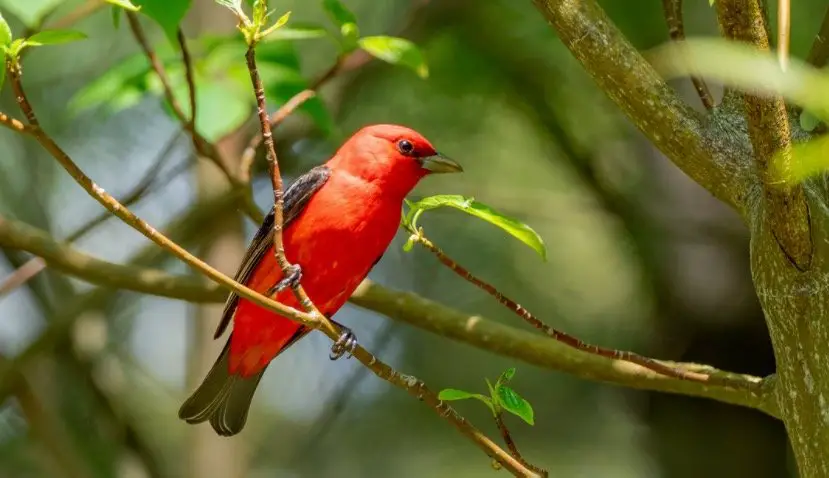
Tips to Attract Scarlet Tanagers to Your Yard
If you’re looking for a small, colorful bird with a big personality, you’ve got it right here: Scarlet Tanagers. These feisty little birds have bright scarlet bodies and black wings, along with very striking facial features. They love to eat insects, fruits and berries—but they especially enjoy bird feeders that are filled with black-oil sunflower seeds.
Plant berry plants, including blackberries, raspberries, huckleberries, juneberries, serviceberries, mulberries, strawberries, and chokeberries, to attract more Scarlet Tanagers. You can find them hanging out in forested areas, so if you don’t have a lot of trees on your property but want to attract these feathered creatures anyway, make sure that you set up a feeder or two in your backyard. This helps promote wildness (and makes them easier to see) without taking away from their natural habitat.
x. Flame-colored Tanagers
Male Flame-colored Tanagers are orange-red birds with darker wings and tails. Females have a yellow-orange coloration. It has a length of 7 to 7.5 inches and a weight of 32 to 48 grams. The Flame-colored Tanager, a rare visitor to the United States, has begun reproducing in Arizona and has been sighted in Texas. They like to live in the woods of Mexico and Central America.
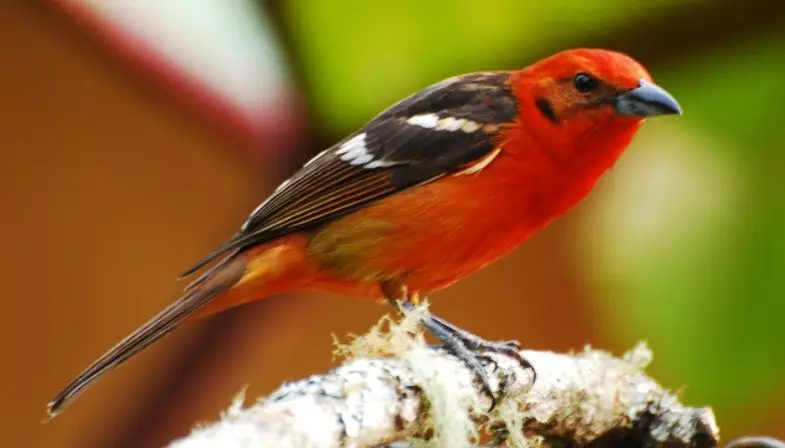
Tips to Attract Flame-colored Tanagers to Your Yard
One of North America’s showiest songbirds, flame-colored tanagers are an active species that flits from tree to tree in search of food. Insects and berries make up their favourite food. Finding a place with lots of fruit trees is a good start, but you can also supplement your garden by building a homemade tanager box.
Even if you don’t see any tanagers for some time, you’ll likely end up with other birds like cardinals and blue jays taking advantage. Stack 2 or 3 horizontal 2x4s at least 6 feet off the ground on which you glue chicken wire or weave a lattice made from thin strips of wood; staple plastic mesh over it to keep out larger predators like cats and squirrels.
xi. Summer Tanagers
Male Summer Tanagers (Piranga rubra) are brilliant red, while females are yellow. It can reach a length of 6.7 inches and a weight of 30 g. They breed throughout the southern and eastern United States before wintering in Central and South America. Forest songbirds that feed on bees and wasps in mid-flight can be found in open forests. They grab them, beat them against a branch, and then massage the stinger off before devouring them.
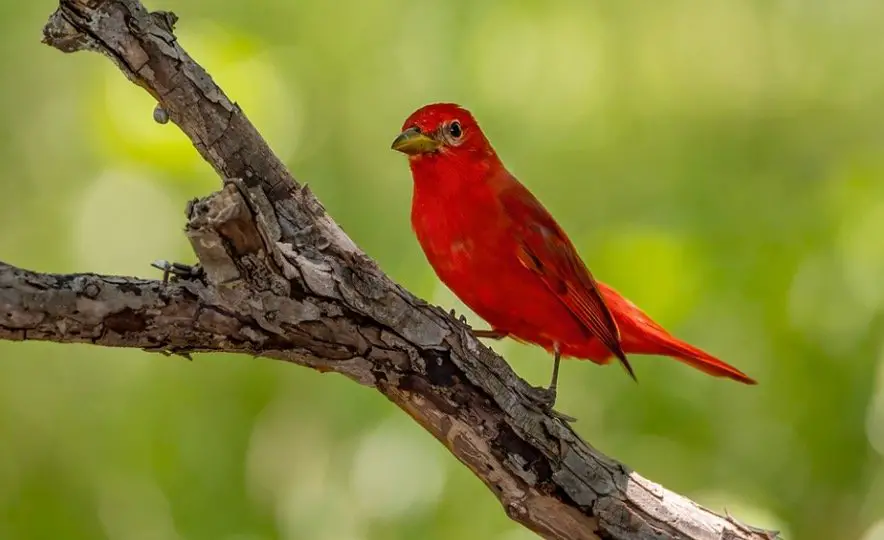
Tips to Attract Summer Tanagers to Your Yard
Summer tanagers, also known as scarlet tanagers or northern cardinals, are strikingly beautiful birds. They live year-round in most areas, and migrate through others. If you’re looking for a quick way to add some summer color to your yard (and aren’t concerned about gardening with perennials), install a bird feeder. Berry plants and fruit trees might help you attract more summer tanagers to your yard.
Tanagers love sunflower seeds and will come right up close while you enjoy their beauty. You can also mix it up with black oil sunflower seeds—the best type for attracting tanagers and other birds—along with cracked corn, safflower seeds and suet cakes (available at pet stores). A simple platform feeder should do fine; it won’t take long for summer tanagers to find it!
xii. Hepatic Tanagers
Male Hepatic Tanagers (Piranga flava) are crimson with grey on their backs. Females are yellow in colour. It can grow to be 3.5 to 7.9 inches long, weighs 23 to 47 g, and has a wingspan of 12.6 inches. Hepatic Tanagers breed in the southern US and Mexico before migrating to Mexico, Central America, and South America for the winter.
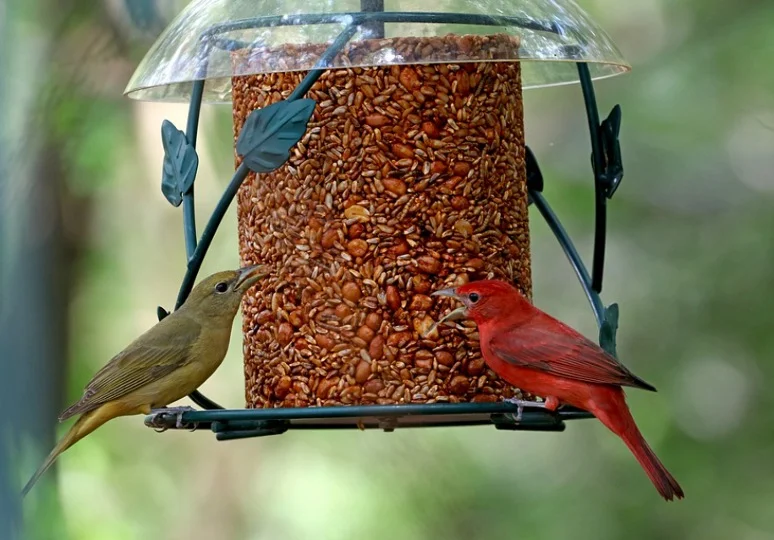
Tips to Attract Hepatic Tanagers to Your Yard
Hepatic tanagers like a bit of an edge in their landscaping, so make sure there are some shrubs in your yard. Avoid too much lawn, since Hepatic tanagers prefer denser landscapes. Maintain your lawn by mowing regularly and keeping it weed-free. Spring is a great time to plant for Hepatic tanagers, but if you missed that opportunity then give seed mixes a try. They feed on insects and spiders and can be found in mountain ranges with pine or pine and oak woods. They’ll also consume fruit like cherries and grapes.
xiii. Red Crossbills
Male Red Crossbills have darker wings and tails than females. Females have a yellow and brown colour scheme. They can be seen throughout the year in the northern and western regions, as well as throughout the winter in eastern states. They hunt in flocks from tree to tree, eating fir seeds and breaking open cones with their strong beaks. They can be seen along roadsides, devouring grit in the mornings, as well as in coniferous forests.
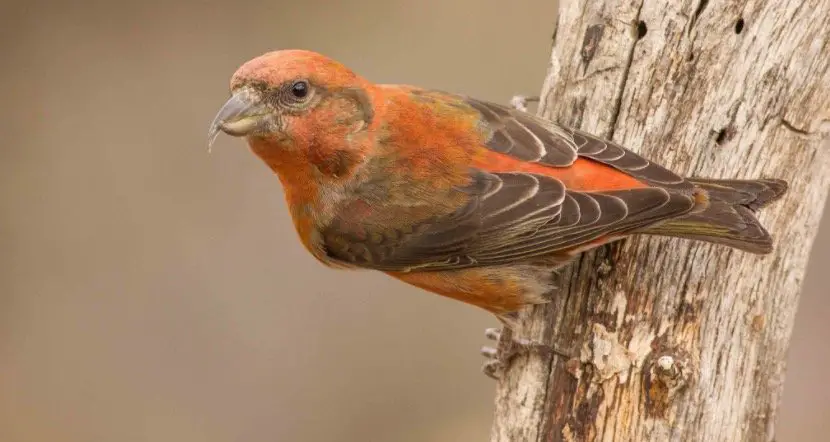
Tips to Attract Red Crossbills to Your Yard
Red Crossbills, commonly referred to as seedeaters, are one of North America’s most distinctive and easily recognized birds. To get your Red Crossbill fix, all you need is a small coniferous tree or bush in your yard. The reason they’re called seedeaters is because they eat seeds—and only seeds! No fruit or insects allowed!
Some people might think that’s bad news for your garden but it can actually be good news if you want some fast-growing seed-filled trees in your yard. However, they aren’t always easy to find. That’s why I recommend attracting them to your own backyard by planting a White Spruce Tree (Picea glauca), which produces long cones filled with bright red seeds!
xiv. White-winged Crossbills
Finches with large crossed beaks are called White-winged Crossbills (Loxia leucoptera). Males have black wings and tails, as well as two white wing-bars. Females have two white wing bands and are yellow and brown. It can reach a length of 5.9 to 6.7 inches, weighs 24 to 26 grams, and has a wingspan of 10.2 to 11 inches.
White-winged Crossbills live in the woods of Canada, Alaska, and occasionally northern US states when cone crops are scarce further north. They graze on seeds and can be found in spruce woods. Unlike other birds, these birds may reproduce at any time of year if there is adequate food. They are frequently heard in huge groups.
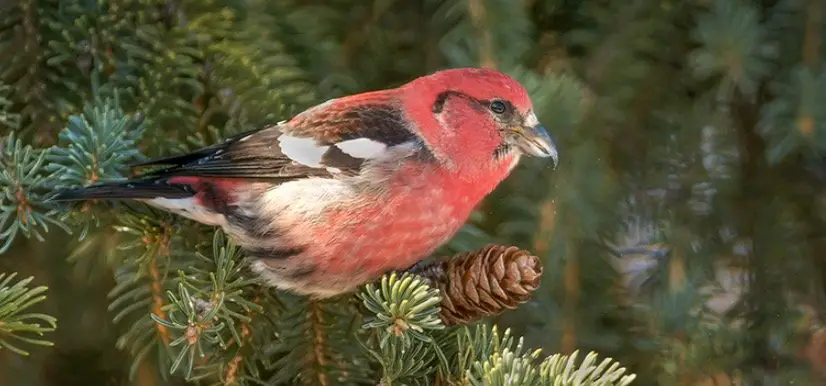
Tips to Attract White-winged Crossbills to Your Yard
White-winged crossbills are among a class of birds known as seed eaters, or granivores. They’ll readily feed on seeds found in cones and pinecones, but they also consume fruit, insects and even sap. White-winged crossbills require thick forests with dense underbrush for nesting sites; since white-winged crossbills are native to North America, their ideal habitat is usually found along mountain ranges. To attract white-winged crossbills to your yard or garden, plant coniferous trees or shrubs—and keep an eye out for pinecones that might have been dropped by squirrels or birds! These birds will gladly consume any old cone that’s lying around.
xv. Pine Grosbeaks
Pine Grosbeaks (Pinacola enucleator) are a finch species. The males have two white wing-bars on their wings and tail, as well as grey on their wings and tail. Females have grey heads and rumps with a faint orange colour. They are huge finches with a modest flight speed. It has a wingspan of 13 inches and a length of 7.9 to 9.8 inches. Pine Grosbeaks are generally found in Canada, although some can be seen near the border, in the western mountains, and in California’s Sierra Nevada. They eat the seeds, fruit, and buds of pine, spruce, and fir trees in pine, spruce, and fir forests.
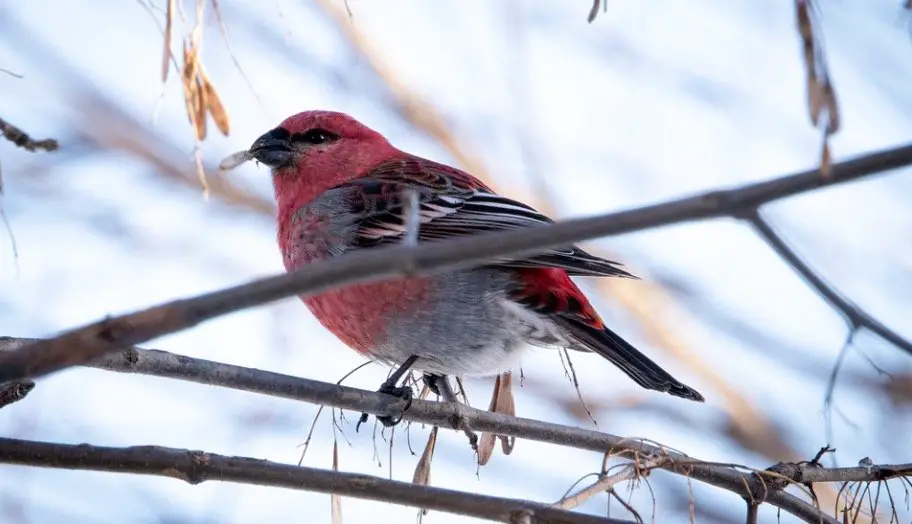
Tips to Attract Pine Grosbeaks to Your Yard
One easy way to attract birds is with bird feeders. Pine grosbeaks are finicky eaters, though, so you’ll want to make sure your feeder provides exactly what they need. Pine grosbeaks like a wide range of seeds, nuts and berries — so you’ll want a feeder that can offer them all these types of food. Try filling it with black oil sunflower seeds and safflower seeds; both are favorites among pine grosbeaks.
In the summer, they will consume insects as well. Pine Grosbeaks are attracted to black oil sunflower seed feeders and suet feeders. While pine grosbeaks love peanuts and peanut butter spread on tree bark or peanut butter feeders, they also enjoy other types of seeds that have been spread on bark, such as striped sunflower and white proso millet.
xvi. Pyrrhuloxias
Male Pyrrhuloxias (Cardinalis sinuatus) are grey with a lot of crimson on their faces, crests, breasts, and tails. Females are a drab grey with a little red. It may reach a length of 8.3 inches and weigh between 24 and 43 grams. They live in the arid regions of Texas, New Mexico, Arizona, and Mexico. They aggressively protect their territories during the mating season, but in the winter, they may be seen in groups of up to 1000 birds.
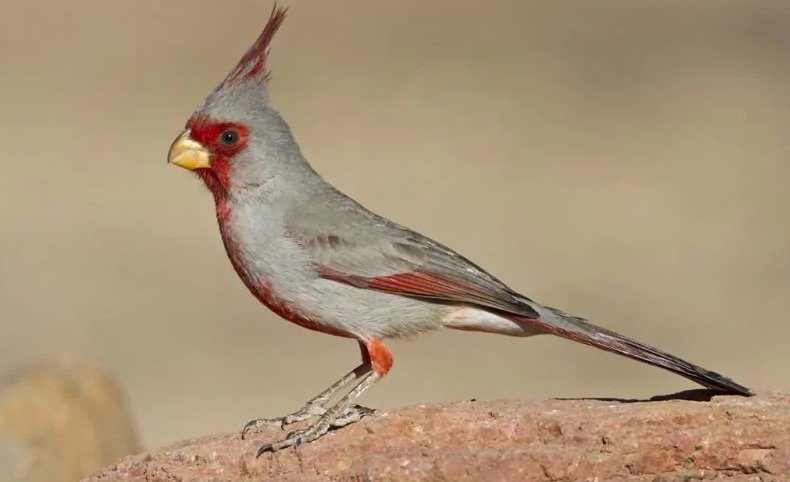
Tips to Attract Pyrrhuloxias to Your Yard
Pyrrhuloxias are a beautiful type of hummingbird, native to Texas and Oklahoma. They’re extremely difficult to attract—but they will visit if you put out at least one feeder in your yard. Pyrrhuloxia eats seeds, but they also eat insects. With that said, if you want several pyrrhuloxias around, you’ll need to put out two or three feeders.
They can be found at sunflower seed feeders, although they prefer to spread them on the ground. Pyrrhuloxias prefer flat-bottomed feeders with lots of reds and greens; most hummingbird feeders fit that description. You’ll also want plenty of blossoms in your yard—most hummers eat insects (especially bees), but they also love fruit, sap, nectar and even sap from trees.
xvii. Painted Buntings
Male Painted Buntings (Passerina ciris) have a vividly variegated patchwork of colour below their plumage, with vibrant blue heads, green wings, and backs. Females are a vibrant yellow-green colour. It may reach a length of 4.7 to 5.1 inches and a weight of 13 to 19 grams. Painted Buntings nest in a few states in the south-central United States, as well as some coastal locations in the Southeast, before migrating to Central America, southern Florida, and the Caribbean islands at night.
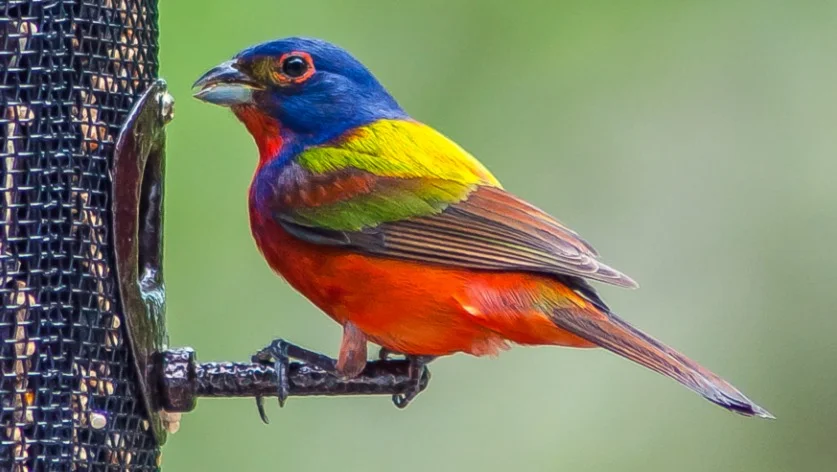
Tips to Attract Painted Buntings to Your Yard
Painted buntings are small, colorful birds with a variety of color variations. They’re known for their ability to flit from one tree branch to another, which makes them fun backyard birds to observe. To attract painted buntings into your yard, you’ll need a large space with plenty of trees and shrubs. Painted Buntings can be seen foraging for seeds and insects in semi-open environments during the breeding season.
Add low-density foliage and seed feeders packed with white millet or black oil sunflower seeds to your yard to attract painted bunting. Offer them water, such as in a birdbath or dish; plant brightly colored annuals and perennials in summer-blooming colors like orange, yellow and red; hang decorations from trees for perching; and put up natural looking nesting boxes containing straw or twigs—painted buntings have been known to use all kinds.
